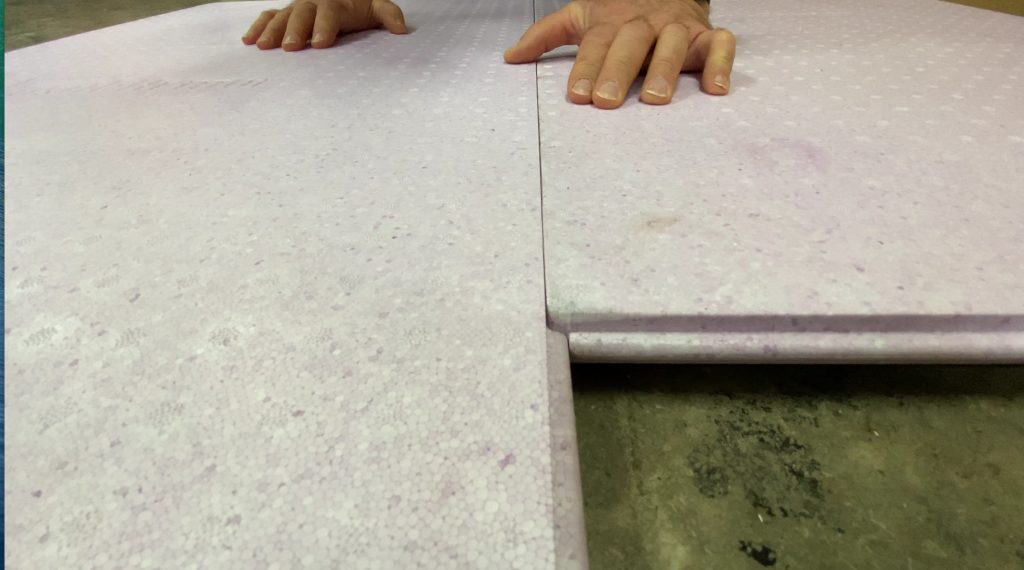A new kind of lightweight, all-foam basement subfloor panels is something you’ll want to consider if you’re finishing your basement.
Autumn is when most basement projects begin, and it’s where the first serious (and often unfixable) basement finishing mistakes occur.
Unfortunately, too many homeowners pay big money to have their basements finished improperly, only to end up with substantially lower indoor air quality over time throughout their house. Hidden mould and mildew growth in the basement is the reason why, and these new subfloor panels make it easier to discourage this kind of disaster.
I’m a big fan of basement subfloor panels. The all-foam panels I’ll show you here are currently my favourite for several practical reasons.
Failure to properly address the unique challenges of finishing a basement is the single most common source of mould and mildew growth, and inadequate basement floor systems is the main cause of trouble.
Building practices that work well above ground can fail miserably over time in hidden ways in basements. Hidden, that is, until mould spores and mildew odours start developing in the basement and wafting into the rest of the house.
For decades, finished flooring such as carpet, vinyl and even hardwood was installed directly on concrete basement floors, in the same way it might be installed in first- or second-storey spaces. This is a mistake that’s still happening in about half the basements I see getting finished.
So, what does finished flooring applied directly to concrete have to do with poor indoor air quality throughout your house? Quite a bit.
Cause of basement mustiness
Have you ever noticed how mould and mildew smells in basements are usually worse in summer? That’s because of a common dynamic that kicks in when an impervious, insulated basement subfloor is not present on a below-ground concrete floor.
When warm, humid outdoor air makes its way into your home and basement, it will continue its journey through the finished flooring if it can. The further this humid air makes its way through, say, carpet pile, the cooler the air gets as it approaches the cool concrete underneath.

In the absence of an impervious subfloor, the air in question can get so close to concrete and so cool that microscopic moisture droplets condense out of the air, appearing within the carpet pile itself. It doesn’t take much moisture to trigger nasty growths in this situation.
Even though I’ve written about this basement floor dynamic many times, I still hear some professional contractors say things like “subfloor panels aren’t necessary — I’ve been finishing basements for 30 years and we’ve never had a problem.” If you ever hear anything like this from a basement contractor you’re planning to hire, run. It’s a classic warning that this person is still finishing basements as if it were 1956, mustiness risk and all. Not good.
The all-foam DRICORE Insul-Armor panels I began testing last year are the best basement subfloor option I’ve seen so far.
Besides having the highest R value of all subfloor panels (R 4.1) and weighing about 80 per cent less than older-style, wood-and-plastic subfloor panels, the all-foam option is not only much lighter to carry downstairs, but a lot easier to cut.

Instead of the sawing required to cut traditional wood-based panels, all-foam panels need only be scored with a utility knife following a straight edge. Snap that scored panel over your knee and it breaks just like it should. No saw noise, no sawdust.
DRICORE Insul-Armor is for the most common hard-surface basement floors such as laminate and luxury vinyl plank and tile. But won’t the foam crush in time from the weight of people walking on the floor? Nope.
With the weight spread around by the hard-surface flooring, these foam panels can handle a pressure of more than 3,000 lbs. per square foot. That’s as heavy as if your car was turned up on end, resting only an a 12-by-12-inch piece of wood sitting on the foam.

If you have your heart set on carpet in your basement (never my recommendation, even with a subfloor) you’ll need to put down at least a ½ inch of plywood on top of the Insul-Armor to support the weight. Something hard and rigid is required over the foam.
Another advantage of Insul-Armor is ease of assembly. The tongue-and-groove edges on neighbouring pieces come together more easily than any of the traditional wood-and-plastic panels — and much more quickly, with no need to us a mallet to drive panels together. That’s me below, putting foam panels together.

Warm, lightweight, easy to cut and mould-inhibiting — what subfloor panel could be better than this?
Here’s a video tour of the all-foam Insul-Armor subfloor panels. At the moment, this is a unique product, so it’s worth seeing them close up.







